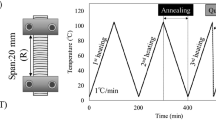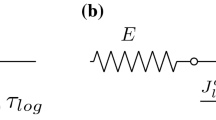Abstract
The viscoelastic properties of wood under water-saturated conditions have been studied in the temperature range 20 to 140° C at frequencies ranging between 0.05 and 20 Hz. It is demonstrated that the major transition in this temperature range is related to aglass transition, i.e. the glass transition of thein situ lignin. The difference in softening behaviour along and across the fibre direction is shown to be related to the stiffening effect of the cellulose microfibrils preferentially aligned along the fibre direction. The softening behaviour is also estimated for frequencies applicable to wood defibration processes, ∼104Hz. The implications of the wood properties under these conditions are discussed.
Similar content being viewed by others
References
I. Sakata andR. Senju,J. Appl. Polym. Sci. 19 (1975) 2799.
D. A. I. Goring,Pulp Paper Mag. Can. 64 (1963) T517.
G. M. Irvine,CSIRO Division of Chemical Technology Res. Rev. (1980) 33.
T. Sadoh,Wood Sci. Technol. 15 (1981) 57.
H. Becker andD. Noack,ibid. 2 (1968) 213.
H. F. Becker,Holz Roh Werkstoff 38 (1980) 301.
W. J. Cousins,Wood Sci. Technol. 12 (1978) 161.
H. Höglund, U. Sohlin andG. Tistad,Tappi 59 (1976) 144.
N. L. Salmén andC. Fellers,Pulp Paper Mag. Can. Trans. Techn. Sec. 8 (1982) TR 93.
M. Htun, PhD thesis, Royal Institute of Technology, Stockholm (1980).
J. Halpin, in “Composite Materials Workshop”, edited by S. W. Tsai, J. C. Halpin and N. J. Pagano (Technomic Publishing Co., Stamford, Conn., 1967) p. 87.
H. Becker, H. Höglund andG. Tistad,Paperi ja Puu 59 (1977) 123.
R. F. Boyer, in “Encyclopedia of Polymer Science and Technology Supplement”, Vol. 2 (Wiley, New York, 1977) p. 745.
D. Braun, P. Törmälä andG. Weber,Polymer 19 (1978) 598.
F. Würstlin andH. Thurn, in “Die Physik der Hochpolymeren”, Vol. 4, edited by H. A. Stuart (Springer Verlag, Berlin, 1956) p. 525.
F. Krum andF. H. Müller,Kolloid-Z. 164 (1959) 81.
D. Atack,Phil. Mag. A43 (1981) 619.
T. L. Smith, “Stress-stiain-time-temperature relationship for polymers”, ASTM Materials Science Series 3, STP-325 (American Society for Testing and Materials, New York, 1962) pp. 60–89.
P. Yang, L. Carlsson andS. S. Sternstein,Polym. Composites 4 (1983) 104.
D. Atack andW. D. May,Tappi 45 (1962) 145.
G. Gavelin,Paper Trade J. 150 (1966) 52.
Author information
Authors and Affiliations
Rights and permissions
About this article
Cite this article
Salmén, L. Viscoelastic properties ofin situ lignin under water-saturated conditions. J Mater Sci 19, 3090–3096 (1984). https://doi.org/10.1007/BF01026988
Received:
Accepted:
Issue Date:
DOI: https://doi.org/10.1007/BF01026988




